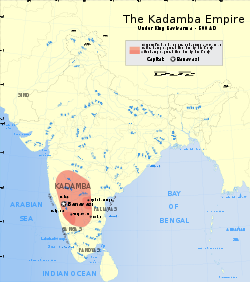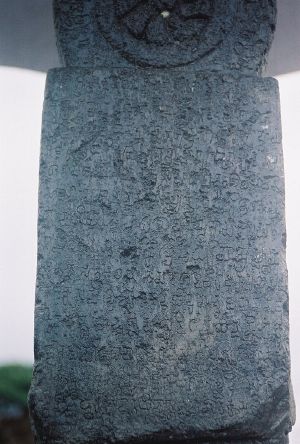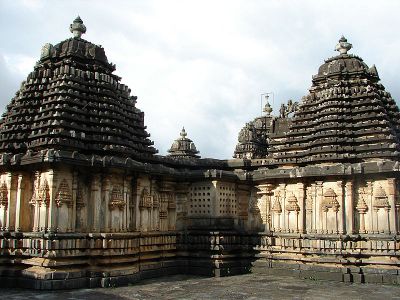Kadamba Dynasty
| |||||||||||||||||||||||||||||||||
The Kadamba Dynasty (Kannada: à²à²¦à²à²¬à²°à³) (345 - 525 C.E.) designates an ancient royal dynasty of Karnataka that ruled from Banavasi in present day Uttara Kannada district. The dynasty later continued to rule as a feudatory of larger Kannada empires, the Chalukya and the Rashtrakuta empires for over five hundred years during which time they branched into Goa and Hanagal. At the peak of their power under King Kakushtavarma, they ruled large parts of Karnataka. During the pre-Kadamba era the ruling families that controlled Karnataka, the Mauryas, Satavahanas and Chutus had immigrated to the region and the nucleus of power resided outside present day Karnataka. The Kadambas emerged as the first indigenous dynasty to use Kannada, the language of the soil at an administrative level. In the history of Karnataka, that era serves as a broad based historical starting point in the study of the development of region as an enduring geo-political entity and Kannada as an important regional language.
Mayurasharma founded the dynasty in 345 C.E., showing at times the potential of developing into imperial proportions, an indication provided by the titles and epithets assumed by its rulers. One of his successors, Kakusthavarma ruled as a powerful sovereign and even the kings of imperial Gupta Dynasty of northern India cultivated marital relationships with his family, giving a fair indication of the sovereign nature of their kingdom. Tiring of the endless battles and bloodshed, one of the later descendants, King Shivakoti adopted Jainism. The Kadambas lived contemporary with the Western Ganga Dynasty of Talakad and together they formed the earliest native kingdoms to rule the land with absolute autonomy.
The Kadamba dynasty collapsed before Mohammed and Islam appeared on the scene in the 600s. Even though the great Hindu empires would fall to the Muslim states, the powerful influence of Hinduism and Jainism would carry on. Much of that strength traces back to the Kadamba dynasty. The decline of the dynasty after less than 200 years appears to have been triggered by disputes in the ruling family, and conflicts with the Gangas and Pallavas. Ravivarma, who ruled from 485, stood as the last ruler to expand the kingdom. Although a dynasty short in duration, less than two centuries, the Kadamba influence passed on to dynasties that followed making its presence felt even today.
History
| Kadamba Kings (345-525) | |
| (Banavasi Kings) | |
| Mayurasharma | (345 - 365) |
| Kangavarma | (365 - 390) |
| Bagitarha | (390 - 415) |
| Raghu | (415 - 435) |
| Kakusthavarma | (435 - 455) |
| Santivarma | (455 -460) |
| Mrigeshavarma | (460 - 480) |
| Shivamandhativarma | (480 â 485) |
| Ravivarma | (485 â 519) |
| Harivarma | (519 â 525) |
| (Triparvatha Branch) | |
| Krishna Varma I | (455) |
| Vishnuvarma | |
| Simhavarma | |
| Krishna Varma II | |
| Pulakesi I (Chalukya) |
(543-566) |
Myths abound about the origin of the Kadambas. According to one account, Trilochana Kadamba, also known from the Halsi and Degamve records as Jayanta, who had three eyes and four arms founded the dynasty.[1] Born out of the sweat of Shiva, which had fallen under a Kadamba tree, he received the Kadamba. According to another myth, Lord Shiva and mother earth gave birth to Mayurasharma, having three eyes. Yet another legend states that Mayurasharma had been born to a sister of Jain Thirtankara Ananda Jinavritindra under a Kadamba tree. All those legends came from the records of the later Hangal Kadambas and Kadambas of Goa.[1]
According to Grama Paddhati, a Kannada work dealing with the history of the Tulu Brahmanas, Lord Shiva and goddess Parvathi gave birth to Mayurasharma under a Kadamba tree in the Sahyadri mountains and hence the name Kadamba. An inscription of the Nagarakhanda Kadambas, a later descendant dynasty, gives a legendary account and traces their lineage back to the Nandas. According to the inscription, King Nanda, who had no heir, prayed to Lord Shiva in the Kailash mountains when a heavenly voice advised him that two sons would be born to him, would bear the name of Kadamba Kula (family) and they should be instructed in the use of weapons.[1]
Theories of Dynasty Origin
Two theories to the origin of the Kadamba dynasty exist, a native Kannadiga origin and the other a north Indian origin. Mention of the north Indian origin of the Kadambas appear only in their later records of their offshoot descendant dynasty, deemed legendary. The earliest record making that claim came from the 1053 and 1055 inscriptions of Harikesari Deva, copied in inscriptions thereafter, describing Mayurasharma as the progenitor of the kingdom who established his might on the summit of Mount Himavat. But that theory has little popular support as early records lack the myth. Royal families of the Deccan in the eleventh-century period often concocted northern origin theories. On the contrary, the family derives its name from the Kadamba tree common only to the South India region.[1]
Historians have divided on the issue of the caste of the Kadamba family, whether the founders of the kingdom belonged to the Brahmin caste as claimed by the Talagunda inscription, or came from tribal origin. A claim has been made that the Kadambas had been a tribe called the Kadambu, who conflicted with the Chera kingdom (of modern Tamil Nadu - Kerala region). The Kadambus' find mention in the Tamil Sangam literature as totemic worshipers of the Kadambu tree and the Hindu god Subramanya, a popular deity in South India.[2] While some historians have argued that they came from Brahmin descent, making Mayurasharma's ancestors natives of northern India, the counter argument reasons that dravidian peoples commonly received into the Brahmanic caste during early and later medieval times. Being native Kannadigas, the Kadambas promptly gave administrative and political importance to their language, Kannada, after coming to power. The reasoning continues that the family of the Kadambas undoubtedly came from Kanarese lineage and may have been admitted into the Brahminical caste. Kadambas had been essentially Mysoreans. The Naga descent of the Kadambas has been stated in early inscriptions of King Krishna Varma I too, which confirms the family came from present day Karnataka.[1]
Inscriptions in Sanskrit and Kannada provide the main sources of the Kadamba history. The Talagunda, Gundanur, Chandravalli, Halasi and Halmidi inscription constitute some of the important inscriptions that throw light on this ancient ruling family of Karnataka. They belonged to the Manavya Gotra and of Haritiputras (lineage), which connects them to the native Chutus of Banavasi, a feudatory of the Satavahana empire. Both the Talagunda and Gundanur inscriptions attest to that.[3] Inscriptions of the Kadambas in Kannada and Sanskrit ascribed to the main dynasty and branch kingdoms have been published by historians. 21 Kannada and two Sanskrit inscriptions have been deciphered and published by George M. Moraes.[1]
The Kadambas minted coins with Nagari, Kannada and Grantha legends which provide additional numismatic evidence of their history. Coins with Kannada legends have been discovered from the rule of the Kadambas.[3] Kadambas had been the first rulers to use Kannada as an additional official administrative language, as evidenced by the Halmidi inscription.[4] The Kadamba-Western Ganga Dynasty era had been of momentous importance to Kannada language for those rulers first gave the Kannada language official language status.[5] Three Kannada inscriptions from their early rule from Banavasi have been discovered. Several early Kadamba dynasty coins bearing the Kannada inscription Vira and Skandha had been found in Satara collectorate. The coins have been preserved at the Archaeological Section, Prince of Wales Museum of Western India, Mumbai. A gold coin of King Bhagiratha (390-415 C.E.) bearing the old Kannada legend Sri and Bhagi also exists. Recent discovery of fifth century Kadamba copper coin in Banavasi with Kannada script inscription Srimanaragi on it proves the usage of Kannada at the administrative level further.
One of their earliest inscriptions, the Talagunda inscription of Santivarma (450) gives what may be the most possible cause for the emergence of the Kadamba kingdom. It states that Mayurasharma had been a native of Talagunda, (in present day Shimoga district) and his family got its name from the Kadamba tree that grew near his home.[3] The inscription narrates how Mayurasharma proceeded to Kanchi in 345 along with his guru and grandfather Veerasarma to prosecute his Vedic studies at a Ghatika (school). There, owing to some misunderstanding between him and a Pallava guard at an Ashvasanstha (a place of horse sacrifice), a quarrel arose in which the guard humiliated Mayurasharma.
In high rage, the Brahmana discontinued his studies, left Kanchi, swearing vengeance on the impudent Pallavas and took to arms. He collected a faithful group of followers and routed Pallava armies near Srisilam region. After a prolonged period of low intensity warfare against the Pallavas and other smaller kings such as the Brihad-Banas of Kolar region he proclaimed independence. Unable to contain him, the Pallavas had to accept his sovereignty. The Talagunda inscription of 450 states the Mayurasharma had been the progenitor of the kingdom. The inscription gives a graphic description of the happenings at Kanchi, "That the hand dexterous in grasping the Kusha (grass), fuel and stones, ladle, melted butter and the oblation vessel, unsheathed a flaming sword, eager to conquer the earth."
Thus, the first native kingdom of Karnataka arose from an act of righteous indignation, the Pallava King Skandavarman condescending to recognize the growing might of the Kadambas south of the Malaprabha river as a sovereign power.[5] The fact that Mayurasharma had to travel to distant Kanchi for Vedic studies gives an indication that Vedic lore had been quite rudimentary in the region at that time. The recently discovered Gudnapur inscription states that Virasarma had been Mauryasharma's grandfather and preceptor, and his father, Bandhushena, developed the character of a Kshatriya. B.R. Gopal discovered the inscription.[6]
Mayurasharma's son, Kangavarma, succeeded him in 365; he had to fight the Vakataka might to protect Kuntala. Vakataka Prithvisena defeated him, he but managed to maintain his freedom. His son Bhagiratha retrieved his fathers losses but Vakataka inscriptions lack testimony to that. The Talagunda inscription describes Bhagiratha as the sole lord of the Kadamba land and the great Sagara himself, indicating he may have retrieved their losses against the Vakatakas.[3] His son, Raghu, died fighting the Pallavas. His brother Kakusthavarma, the most ferocious and powerful ruler of the kingdom, succeeded him. He maintained similar relations with the Bhatari, the Alupas of South Canara and the Western Ganga Dynasty of Gangavadi according to the Talagunda inscription. The great poet Kalidasa had visited his court.
After Kakusthavarma only Ravivarma who came to the throne in 485 succeeded in building up the kingdom. A series of clashes within the family, and also against the Pallavas and the Gangas, marked his rule. He received credit for defeating the Vakatakas, extending his Kingdom as far north as the river Narmada. The crux of their kingdom essentially consisted of most of Karnataka, Goa and southern areas of present day Maharashtra. After his death, the kingdom went into decline due to family feuds. The Birur plates of Kadamba Vishnuvarman call Shantivarman "The master of the entire Karnataka region." The Triparvatha branch that broke away in 455 ruled from Murod in Belgaum for some time and merged with the main Banavasi kingdom during rule of Harivarma. Finally the kingdom fell to the prowess of the Badami Chalukyas. The Kadambas thereafter became feudatories of the Badami Chalukyas and later the Rashtrakutas and Kalyani Chalukyas. The successors of Mayurasharma took to the name "varma" to indicate their Kshatriya status.
Administration
The Kadamba kings called themselves Dharmamaharajas like the Satavahana kings. Dr. Mores has identified various cabinet and other positions in the kingdom from inscriptions. The prime minister (Pradhana), Steward (Manevergade), secretary of council (Tantrapala or Sabhakarya Sachiva), scholarly elders (Vidyavriddhas), physician (Deshamatya), private secretary (Rahasyadhikritha), chief secretary (Sarvakaryakarta), chief justice (Dharmadhyaksha) and other officials (Bhojaka and Ayukta). The army consisted of officers like Jagadala, Dandanayaka and Senapathi.
A crown prince from the royal family helped the king in administration. Princesses of the royal family received appointments as governors of various provinces. King Kakusthavarma had appointed his son Krishna as viceroy of Thriparvataha region. That later proved detrimental to the kingdom as it gave opportunity for break away factions in the kingdom.
The kingdom divided into Mandalas (provinces) or Desha. Under a Mandala had been Vishayas (districts). A total of nine Vishaya have been identified.[3] Under a Vishaya had been Mahagramas (Taluk) and Dashagramas (Hobli). Mahagrama had more villages than Dashagramas. One sixth of land produce had to be paid as tax. Taxes included Perjunka (levy on load), Vaddaravula (social security tax for royal family), Bilkoda (salex tax), Kirukula (land tax), Pannaya (betel tax) and other professional taxes on traders.
Culture
Religion
The Kadambas followed Vedic Hinduism. The founder, Mayurasharma had been a Brahmin by birth but later his successors changed their surname to Varma to indicate their Kshatriya status. Some Kadamba kings like Krishna Varman performed the horse sacrifice (Ashwamedha). Their Talagunda inscription starts with an invocation of Lord Shiva while the Halmidi and Banavasi inscriptions start with an invocation of Lord Vishnu. They built the Madhukesvara temple, considered their family deity. Many records like the Kudalur, Sirsi records speak of grants made by them to scholarly Brahmins as well as to Buddhist viharas.
The Kadambas also patronized Jainism and built numerous Jain temples scattered around Banavasi, Belgaum, Mangalore and Goa. Kings and Queens of the dynasty won renown for their support of literature, arts and liberal grants to temples and educational institutions. Several descendants scatter around present day Goa, Belgaum, Mangalore and Bangalore. Adikavi Pampa highly spoke of that kingdom in his writings, as indicated by his famous quotes on Banavasi: Aaramkushamittodam nenevudenna manam banavasi deshamam (I shall cherish the sweet memories of Banavasi even when tortured), Maridumbiyagi mEN Kogileyagi puttuvudu nandanadol Banavasi deshadol (As a bee or as nightingale should one born here in this beautiful country of Banavasi).[6]
Architecture
The contribution of the Kadambas to the architectural heritage of Karnataka certainly deserves recognition.[7] The Kadamba style has distinguishing characteristics, including a few things in common with the Chalukyan and the Pallava styles. They drew from the architectural tradition of the Satavahanas. Shikara, called Kadamba Shikara, constitutes the most prominent feature of their architecture. The Shikara has a pyramid shape and rises in steps, without any decoration, with a Stupika or Kalasha at the top. That style of Shikara had been used several centuries later in the Doddagaddavalli Hoysala temple and the Mahakuta temples in Hampi. Some of their temples also used perforated screen windows. In architecture and sculpture, the Kadambas contributed to the foundation of the later Chalukya-Hoysala style.[3]
The Madhukeshwara (Lord Shiva) temple built by them still exists in Banavasi. Built in tenth century and renovated many times, the temple represents the pinnacle of their art. The stone cut with wonderful carvings attracts many who appreciate magnificent art to the temple.
Impact
Kadambotsava ("The festival of Kadamba"), represents a festival celebrated every year by Government of Karnataka in honor of this kingdom.[8] A popular Kannada film of yester years Mayura starring Dr. Raj Kumar celebrates the creation of the first Kannada kingdom.
On May 31, 2005, Defence minister Pranab Mukherjee commissioned India's most advanced and first dedicated military naval base named INS Kadamba after the Kadamba dynasty, in Karwar.[9]
Notes
- â 1.0 1.1 1.2 1.3 1.4 1.5 George M. Moraes, The Kadamba Kula (Andesite Press, 2015, ISBN 978-1296615086).
- â P.N. Chopra, T.K. Ravindran, and Nilakanta K.A Subrahmanian, History of South India: Ancient, Medieval Modern (S. Chand & Company, 2003, ISBN 978-8121901536).
- â 3.0 3.1 3.2 3.3 3.4 3.5 Suryanath U. Kamath, A Concise History of Karnataka from pre-historic times to the present (Total Kannada, 2018).
- â Lalit Chugh, Karnataka's Rich Heritage - Art and Architecture: From Prehistoric Times to the Hoysala Period (Notion Press, 2016, ISBN 978-9352068241).
- â 5.0 5.1 K.V. Ramesh, Chalukyas of Vatapi (Delhi: Agam Kala Prakashan, 1984).
- â 6.0 6.1 Karnataka Our Karnatka. Retrieved March 20, 2023.
- â Jyotsna Kamat, Ancient City of Banavasi Kamat's Potpourri. Retrieved March 20, 2023.
- â Kadambotsava at Banavasi The Hindu, February 6, 2015. Retrieved March 20, 2023.
- â INS Kadamba Indian Navy. Retrieved March 20, 2023.
ReferencesISBN links support NWE through referral fees
- Chopra, P.N., T.K. Ravindran, and Nilakanta K.A Subrahmanian. History of South India: Ancient, Medieval Modern. S. Chand & Company, 2003. ISBN 978-8121901536
- Chugh, Lalit. Karnataka's Rich Heritage - Art and Architecture: From Prehistoric Times to the Hoysala Period. Notion Press, 2016. ISBN 978-9352068241
- Kamath, Suryanath U. A Concise History of Karnataka from pre-historic times to the present. Total Kannada, 2018. ASIN B08B5CKPBJ
- Moraes, George M. The Kadamba Kula. Andesite Press, 2015. ISBN 978-1296615086
- Ramesh, K. V. Chalukyas of VÄtÄpi. Delhi: Agam Kala Prakashan, 1984. ASIN B0006EHSP0
- Rice, B.L. Mysore Gazatteer Compiled for Government-vol 1, 1897. New Delhi: Asian Educational Services, 2001. ISBN 8120609778
External Links
All links retrieved February 28, 2025.
- Kadambas of Banavasi by Dr. Jyotsna Kamat
- Indian Inscriptions Archeological Survey Of India
Credits
New World Encyclopedia writers and editors rewrote and completed the Wikipedia article in accordance with New World Encyclopedia standards. This article abides by terms of the Creative Commons CC-by-sa 3.0 License (CC-by-sa), which may be used and disseminated with proper attribution. Credit is due under the terms of this license that can reference both the New World Encyclopedia contributors and the selfless volunteer contributors of the Wikimedia Foundation. To cite this article click here for a list of acceptable citing formats.The history of earlier contributions by wikipedians is accessible to researchers here:
The history of this article since it was imported to New World Encyclopedia:
Note: Some restrictions may apply to use of individual images which are separately licensed.


